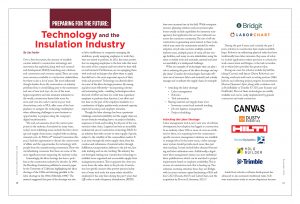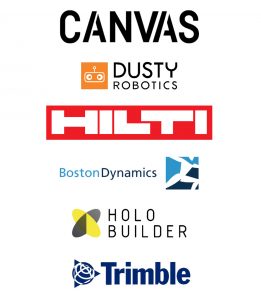Preparing for the Future: Technology and the Insulation Industry
Over a few short years, the amount of available content related to construction technology and innovation has exploded, along with tech research and development (R&D), launching new solutions and construction tech venture capital. There are many more resources available to construction stakeholders, but there is also a lot of noise. The most influential thought leaders focus the conversation on industry problems first, to avoid falling prey to the excitement and awe of new tech toys. As one of the most hypercompetitive and risk-intensive industries in the world, construction leaves little room for error, and even less cash to invest in poor tech. Associations, such as NIA, offer some of the best guidance to navigate the technology marketplace when addressing challenges in your business or opportunities to progress along the company’s digital transformation.
We read, ad nauseum, about the current pain points in the industry. Articulated in many ways, today’s most inhibiting issues include the labor shortage and supply chain issues, coupled with escalating material costs. At NIA’s 65th Annual Convention this year, I had the opportunity to discuss the current state of affairs and the opportunities for technology with people from the manufacturing community. There was overwhelming consensus that these are some of the most significant issues impacting the industry today.
Interestingly, the labor shortage has been a problem in the construction industry for decades. In 1989, the Brookings Institution published a research paper by the University of California highlighting the labor shortage of the 1980s and drawing parallels to the labor shortage in the 1960s (Mitchell, 1989).1 The research suggested that part of the shortage was due to labor inefficiency in companies managing the workforce, poorly assigning employees to work they were not suited to perform. In 2021, this issue persists. Are we assigning employees to the best roles that meet the needs of the company and best suited to their skill set and interests? Furthermore, are we equipping them with tools and techniques that allow them to apply that skill set to the most important aspects of their work and processes? Technology can directly alleviate some of the labor shortage pressures. By managing labor more effectively—incorporating robotics and automating tasks—enabling technologies reduce the level of effort and time for a full-time equivalent employee to perform their function. Less effort and less time on the part of the employee translates to a combination of higher quality work, increased capacity, improved accuracy, and employee retention.
Though the labor shortage has been a persistent challenge, material availability and the supply chain are recent obstacles wreaking havoc on project schedules, sequences of work, and backlog for all parts of the construction value chain. Logistics has been an incredibly underserved area of construction technology R&D for an industry that relies on just-in-time supply of goods, subject to the volatility of the commodities market. It is an issue through the entire supply chain, from the creation and submission of material orders through fulfillment, transportation, delivery to the job site, last-mile tracking, and on-site tracking. The industry has not leveraged existing non-construction technology to establish more organized and accountable supply chain management practices. This is apparent the closer you move down the value chain to the job site. Construction has specific nuances that prevent practical adoption of some tech tools, but many others should be employed. It has only been during the past 5 years that QR codes or radio-frequency identification (RFID) have seen increased use in the field. While enterprise resource planning solutions and procurement platforms usually include capabilities for inventory management, that application has not seen widescale use across the contractor community. The rise of off-site construction is generating more interest in these tools, which may create the momentum needed for wider adoption. As job sites can have multiple material laydown areas, multiple points of entry, off-site storage facilities, and many on-site stakeholders using the same or similar tools and materials, material and asset accountability is a widespread challenge.
What are examples of technologies that can play a role in reducing the pain of the labor shortage and supply chain? Consider the technologies that make efficient use of resources (labor and material) and actively manage and coordinate the supply chain, for example:
- Attacking the labor shortage
• Labor management
• Robotics
• Task automation - Slaying material and supply chain woes
• Inventory control and material tracking
• Job site logistics management
• Project scheduling
Attacking the Labor Shortage
Labor management tech is not a new area of software development, but adoption has lagged in construction. In an industry where 50% or more of costs are attributed to labor, it is surprising how few construction-specific resources management solutions are available to manage labor. In the truest sense, a labor management system should provide much more than just time tracking. It must include labor demand forecasting and labor utilization rates. Additionally, a legitimate labor management system can store individual labor qualifications, which can be matched to project requirements based on employee availability. This is an area of construction tech that is heating up. Two solutions receiving attention these days are Bridgit, with its recent venture capital fundraising of $24 million CAD (Donati, 2021)2; and LaborChart, and the acquisition by Procore (Lehrmann, 2021).3
During the past 8 years, and certainly the past 3 years, robotics in construction have made incredible leaps. Robotics are addressing physical tasks that have traditionally been labor intensive. Key areas of robotics include applications where precision is critical, the work causes strain and fatigue, or the task is incidental to where labor provides the greatest value.
Strong use cases for robotics include drywall finishing (Canvas); wall layout (Dusty Robotics); conducting overhead, work such as setting anchors (Hilti Jaibot); and collecting project progress documentation (Boston Dynamic’s Spot, along with a solution such as HoloBuilder or Trimble X7 3D Laser Scanner and FieldLink). Most of these technologies are readily available and can be easily implemented by general contractors and trade contractors.
Aside from robotics, software development has advanced to also automate traditional tasks. Software automation tends to receive skepticism because employees are concerned that it reduces their importance in the company, and the industry questions the ability for software to be as effective as intuition or experience. This can be overcome with education and awareness, since software companies would agree that the intent is not to reduce the value of the worker. Rather, the objective is to allow employees to spend their time analyzing the “so what” and taking action instead of aggregating and organizing information.
Three solutions that are pushing the boundaries in this area through early R&D or as a new commercial solution are SHADE Technologies, Togal.AI, and IPSUM’s ProPlanner.
- SHADE offers an alternative to the somewhat complex building information model with an augmented reality-based platform that renders building information in the physical environment beyond what has been labeled the digital twin. Its use is focused on documenting building characteristics and building system components for collaboration, in a way that makes it practical and useful to field personnel. SHADE remains useful beyond construction when used by maintenance teams. The technology significantly reduces the amount of time searching for information on paper, in PDFs, or in the 3D model. It operates on an ultra-wide brand network that enables a level of accuracy and orientation not possible through other means.
- Togal.AI is commercially available automated construction takeoff and estimating software that allows a user to upload a PDF drawing of a building, click a button, and receive the area/linear foot/quantity takeoff in moments.
- IPSUM ProPlanner is a scheduling and schedule analytics platform that looks and feels like Microsoft Project and Primavera P6 but allows for schedule versioning and across-version analytics to understand what is causing schedule issues.
Slaying Material and Supply Chain Woes
Technology providers are attacking this issue in many ways. Some prefer to focus on a simplified solution for a specific pain point, while others are delivering a full-featured logistics management system.
Simplified solutions include BitRip, an easier and more effective solution than QR codes and bar coding. BitRip is a tape roll of unique code-based imagery that you can tear off and apply to any asset (materials, tools, equipment), log with their mobile web app, and track the chain of custody. The simplicity of ripping off a piece of tape and an easy mobile app make this a scalable solution across many company and project sizes.
Voyage Control is an Australian-based logistics management platform that was initially developed for the events industry, but people quickly realized there was an opportunity to help lead the construction industry. The platform is a full-feature, mobile device friendly job site logistics management solution that includes delivery scheduling and monitoring, broad transportation management, and materials management.
Looking Ahead
These are just a sample of some of the newer technologies that are receiving venture investment and early traction to tackle old problems in new ways, or new problems quickly. Still, hurdles are abundant in the overall technological evolution of construction. Because of the proliferation of ideas, R&D, venture capital, and new solutions, the industry is confused about what technology is best suited to meet its needs. The construction industry now has approximately 30 categories of technology, all seeking to improve the business and project performance of their customers. The rigor and pace of change is at odds with an industry that has little time, single-digit margins, and eroding backlog. However, over time, the technology solutions that prove their worth will rise to the top, just as contractors continue to build out their technology teams and processes for conducting pilots and implementing solutions.
In the coming years, we will see an acceleration of technology R&D focused on even more
opportunities to digitize and refine the industry’s ways, including data management, prescriptive analytics, cashflow management/invoice factoring, on-demand market intelligence, construction building products e-Commerce, and more.
As you wrestle with the challenges of our day, push your company to look toward technology as a part of the answer, alongside people and process. Refrain from chasing the latest tech toy, listen to the needs of your end users, and provide the resources (time, money, people, training) across all solutions in your tech stack.
References
1. Mitchell, D. J. (1989). Brookings Papers on Economic Activity: University of California. Retrieved from Brookings Institution: www.brookings.edu/wp-content/uploads/1989/06/1989b_bpea_mitchell.pdf
2. Donati, A. K. (2021, October 26). Workforce Intelligence Contech Startup Bridgit Raises CA$ 24 Million Series B. Retrieved from www.forbes.com/sites/angelicakrystledonati/2021/10/26/workforce-intelligence-contech-startup-brigit-raises-ca-24-million-series-b/?sh=7b78d7103a30
3. Lehrmann, W. (2021, October 22). Retrieved from Procore: https://blog.procore.com/procore-acquires-laborchart-to-improve-construction-workforce-management/





